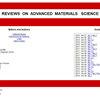新型三元磁性复合材料的合成与表征--增强去除有机染料的吸附能力
IF 3.6
4区 材料科学
Q2 MATERIALS SCIENCE, MULTIDISCIPLINARY
引用次数: 0
摘要
在室温下采用简便的机械搅拌工艺,将基于金属锌(ii)、有机连接剂苯-1,3,5-三羧酸(Zn-BTC)、Fe3O4 纳米粒子和纳米纤维素的金属有机框架(MOF)结合在一起,创造出一种名为 Fe3O4/NC/MOF 的新型复合材料。我们使用了多种工具来表征所创建的复合材料。使用 Fe3O4/NC/MOF 有效地消除了水中的刚果红、碱性蓝 54 (BB54)、碱性紫 14 (BV 14) 和酸性红 88 (AR 88) 染料。研究了多个变量,包括 pH 值、温度、接触时间、初始染料浓度和吸附剂用量。为了解具体的吸附过程,使用了一些动力学模型,包括颗粒内扩散模型、埃洛维奇动力学模型、伪一阶和伪二阶动力学模型。伪二阶动力学模型对染料吸附动力学的描述最为准确。此外,Langmuir 模型比 Freundlich 和 Temkin 模型更能准确地描述等温线。此外,还获得并研究了热力学参数,包括焓(ΔH)、吉布斯自由能(ΔG)和熵(ΔS)。经过四个循环后,Fe3O4/NC/MOF 表现出良好的可回收性。根据实验研究,这种吸附剂有望改善受有机染料污染的环境水质。本文章由计算机程序翻译,如有差异,请以英文原文为准。
Synthesis and characterization of a novel ternary magnetic composite for the enhanced adsorption capacity to remove organic dyes
Using an easy mechanical agitation process at room temperature, a metal–organic framework (MOF) based on metallic Zn(ii ), organic linker benzene-1,3,5-tricarboxylic acid (Zn-BTC), Fe3 O4 nanoparticles, and nanocellulose are combined to create a novel composite material called Fe3 O4 /NC/MOF. Various tools were used to characterize the created composite. Congo red, Basic Blue 54 (BB 54), Basic Violet 14 (BV 14), and Acid red 88 (AR 88) dyes were effectively eliminated from water using Fe3 O4 /NC/MOF. A number of variables were investigated, including pH, temperature, contact time, initial dye concentration, and adsorbent dosage. To understand the specific adsorption process, a number of kinetic models were used, including the intra-particle diffusion model, Elovich’s kinetic model, pseudo-first-order, and pseudo-second-order kinetic models. The most accurate description of dye sorption kinetics comes from the pseudo-second-order kinetic model. Also, the Langmuir model is more accurate to describe isotherms than Freundlich and Temkin models. Furthermore, thermodynamic parameters were obtained and examined, including enthalpy (ΔH ), Gibbs free energy (ΔG ), and entropy (ΔS ). After four cycles, the Fe3 O4 /NC/MOF demonstrated good recyclability. According to experimental research, this adsorbent is promising to enhance the quality of environmental water that has been tainted with organic dyes.
求助全文
通过发布文献求助,成功后即可免费获取论文全文。
去求助
来源期刊

Reviews on Advanced Materials Science
工程技术-材料科学:综合
CiteScore
5.10
自引率
11.10%
发文量
43
审稿时长
3.5 months
期刊介绍:
Reviews on Advanced Materials Science is a fully peer-reviewed, open access, electronic journal that publishes significant, original and relevant works in the area of theoretical and experimental studies of advanced materials. The journal provides the readers with free, instant, and permanent access to all content worldwide; and the authors with extensive promotion of published articles, long-time preservation, language-correction services, no space constraints and immediate publication.
Reviews on Advanced Materials Science is listed inter alia by Clarivate Analytics (formerly Thomson Reuters) - Current Contents/Physical, Chemical, and Earth Sciences (CC/PC&ES), JCR and SCIE. Our standard policy requires each paper to be reviewed by at least two Referees and the peer-review process is single-blind.
 求助内容:
求助内容: 应助结果提醒方式:
应助结果提醒方式:


